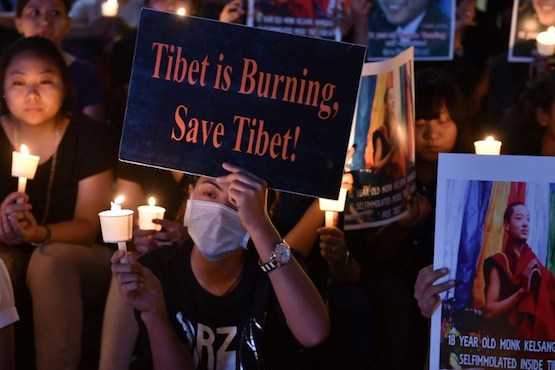
It's the absolute example of resistance against communist rule

Tibetan refugees hold placards and candles during a vigil following the self-immolation of two Tibetans in Bangalore on March 5, 2016. Self-immolations by Tibetans are fraught protests against Beijing's ironclad control of the Himalayan region. (Photo by Manjunath Kiran/AFP)
Young Tibetan farmer Pema Gyaltsen set himself on fire on March 18, in Ganzi Tibetan Autonomous Prefecture in Sichuan province to protest communist rule.
This is the 147th self-immolation in China since 2009. Six exiled Tibetans have also set themselves on fire in that time. So far, 126 people in China and four overseas died in these protests.
The first self-immolation took place in Aba Tibetan and Qiang Autonomous Prefecture in Sichuan in February, 2009. The self-immolator was 20-year-old Tibetan monk Tapey.
After the second self-immolation in 2011, these tragedies increased. There were as many as 85 such protests in 2012, with 28 people setting themselves on fire in November alone. In 2016, four people died of self-immolation.
Self-immolations have occurred through Tibet's three traditional provinces: U-Tsang, Amdo and Kham. According to the Chinese government, the provinces are now under jurisdictions of Tibet Autonomous Region and provinces of Gansu, Qinghai and Sichuan.
The protesters included Tulkus (reincarnated lamas), monks, nuns, high school students, herdsmen and farmers.
The oldest self-immolator was 64-years-old while the youngest was 15. When they set fire on themselves, they shouted slogans: "Let Venerable Dalai Lama return to Tibet", "Pray for long life of Venerable Dalai Lama", "Tibet needs freedom," "Tibet independence" or "Release the 11th Panchen Lama."
The ongoing nature of the self-immolations have shocked the world, becoming the most tragic protests in human history. The protests were triggered after the bloody crackdown of peaceful and non-violent protests in 2008. The common thing of these self-immolators was: they set themselves on fire without hurting others, not even the military and police officers who suppress and slaughter Tibetans.
To discredit the resistance against tyranny and to cover up the truth of its unprecedented oppression in Tibet, the Chinese communists first defamed the self-immolators as people who might suffer from epilepsy or mental problems, might be thieves, having improper sexual relationships, or as a dispute between a husband and wife.
They even viciously slandered the self-immolation of Tibetan as "the clique of Dalai Lama gave money to buy corpses." Later, they accused "the clique of Dalai Lama of incitement and instigation" and "terrorist acts." But the communists so far have not provided any evidence.
The communist government defined self-immolation as a criminal offence. Despite such moves however, the self-immolations did not stop but increased dramatically. The authorities then began collective punishment on self-immolators' families, villages, temples and people who sent condolences and prayed for them.
More than 80 Tibetans have been sentenced for having a connection with the self-immolators, for "instigating" such protests or for spreading news of self-immolations. Among sentences given include the death penalty and life imprisonment. Yet, the fire of self-immolation still could not be extinguished.
But why self-immolation? Famous Tibetan writer Tsering Woeser studied the statements or slogans shouted out by 51 self-immolators just before they set themselves alight.
Before their protests, she found that the self-immolators had waited passively for the exiled Tibetan government or the international community to help resolve the Tibet issue but finally they realized that they must rely on themselves.
From their last words, she said, one could see that their motivation did not have any trace of violence. As such, self-immolation is the Tibetan's absolute example of resistance against communist rule. One that is the greatest and most tragic wave of political protests in modern history.
“One may not dare to commit self-immolation but if one dares only to imagine the act, he or she would see the heroic and tragedy of the self-immolators using their insignificantly small bodies to fight against the huge tyranny machine," said Woeser.
Speaking on self-immolation, famous Chinese artist Ai Weiwei said "Tibet is the most difficult question for China and the international community to answer regarding human rights and fairness. No one can avoid or get around it. So far, no one can escape humiliation."
The self-immolation protests have shocked the Tibetan society and caused distress. There were appeals from the exiled government, religious leaders and intellectual circle not to take such extreme action no matter how serious oppression is.
However, self-immolation protests are still happening in Tibet, which shows how extremely cruel the Chinese Communists' colonial policy is.
The only way to resolve the self-immolations is for the Chinese government to stop its suppressive policies and to listen to the real aspirations of the people. It is also the only way to resolve the very real issues faced by the Tibetan people.
Sang Jieja is a Tibetan writer, commentator and former Chinese spokesman of the exiled Tibetan government. He is currently studying in Spain.
Help us keep UCA News independent
The Church in Asia needs objective and independent journalism to speak the truth about the Church and the state.
With a network of professionally qualified journalists and editors across Asia, UCA News is just about meeting that need. But professionalism does not come cheap. We depend on you, our readers, to help maintain our independence and seek that truth.
A small donation of US$2 a month would make a big difference in our quest to achieve our goal.

Share your comments